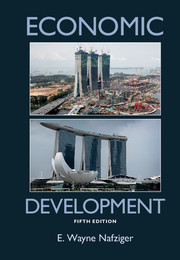Book contents
- Frontmatter
- Contents
- Preface to the Fifth Edition
- Abbreviations and Measures
- Part One. Principles and Concepts of Development
- Part Two. Poverty Alleviation and Income Distribution
- Part Three. Factors of Growth
- Part Four. The Macroeconomics and International Economics of Development
- 14 Monetary, Fiscal, and Incomes Policies and Inflation
- 15 Balance of Payments, Aid, and Foreign Investment
- 16 The External Debt and Financial Crises
- 17 International Trade
- Part Five. Development Strategies
- Glossary
- Bibliography
- Index
- Endpapers
- References
14 - Monetary, Fiscal, and Incomes Policies and Inflation
from Part Four. - The Macroeconomics and International Economics of Development
Published online by Cambridge University Press: 05 June 2012
- Frontmatter
- Contents
- Preface to the Fifth Edition
- Abbreviations and Measures
- Part One. Principles and Concepts of Development
- Part Two. Poverty Alleviation and Income Distribution
- Part Three. Factors of Growth
- Part Four. The Macroeconomics and International Economics of Development
- 14 Monetary, Fiscal, and Incomes Policies and Inflation
- 15 Balance of Payments, Aid, and Foreign Investment
- 16 The External Debt and Financial Crises
- 17 International Trade
- Part Five. Development Strategies
- Glossary
- Bibliography
- Index
- Endpapers
- References
Summary
Monetary policy affects the supply of money (primarily currency and bank demand deposits) and the rate of interest. Fiscal policy includes the rate of taxation and the level of government spending. Incomes policy consists of antiinflation measures that depend on income and price limitations, such as moderated wage increases.
The governments of developed countries (DCs) use monetary and fiscal policies to achieve goals for output, employment, and price stability. Thus, during a recession, with slow or negative growth, high unemployment, and surplus capacity, these governments reduce interest rates, expand bank credit, decrease tax rates, and increase government spending to expand aggregate spending and accelerate growth. By contrast, DC governments are likely to respond to a high rate of inflation (general price increase) with increased interest rates, a contraction of bank credit, higher tax rates, decreased government expenditures, and perhaps even wage–price controls to reduce total spending.
Often DCs do not attain their macroeconomic goals because of ineffective monetary and fiscal tools, supply (such as oil price) shocks, political pressures, or contradictory goals. Thus, we have the quandary during stagflation or inflationary recession (in the West during the 1970s) of whether to increase aggregate spending to eliminate the recession or decrease spending to reduce inflation.
- Type
- Chapter
- Information
- Economic Development , pp. 451 - 485Publisher: Cambridge University PressPrint publication year: 2012

